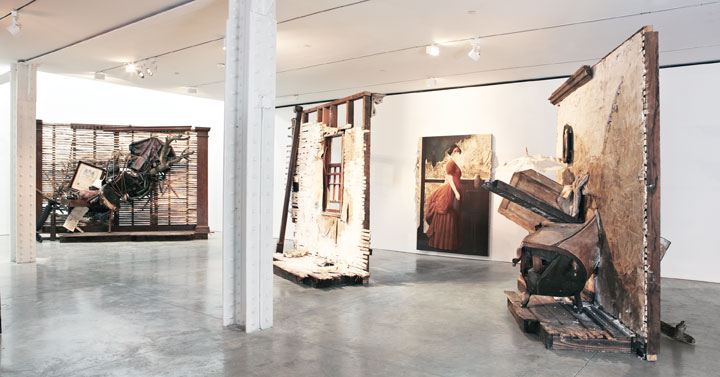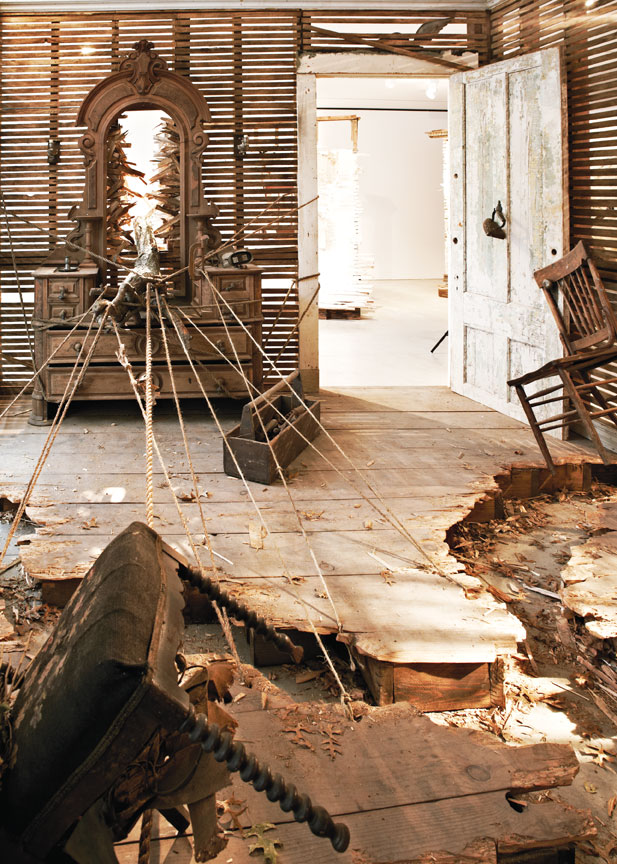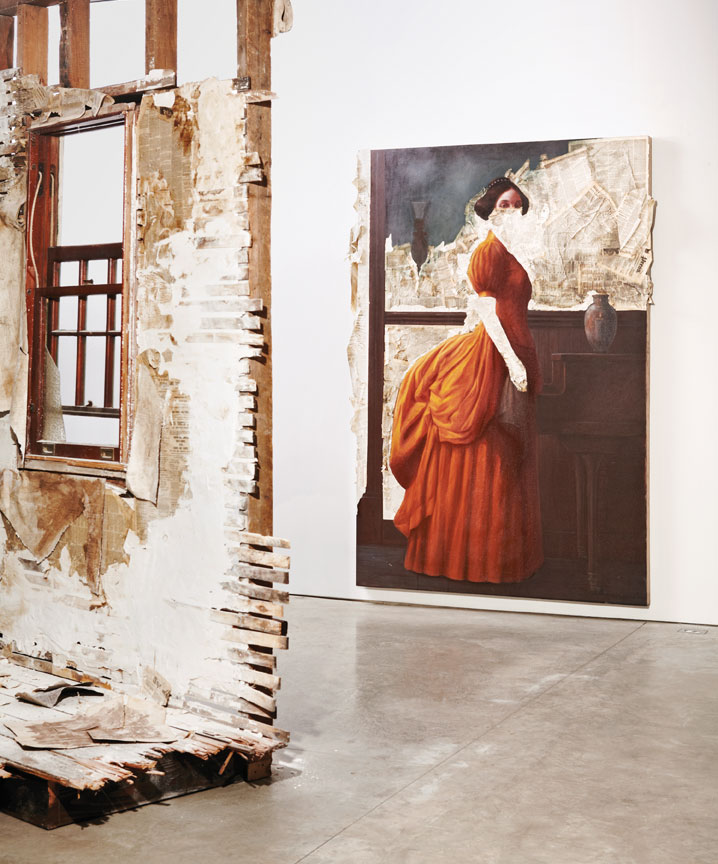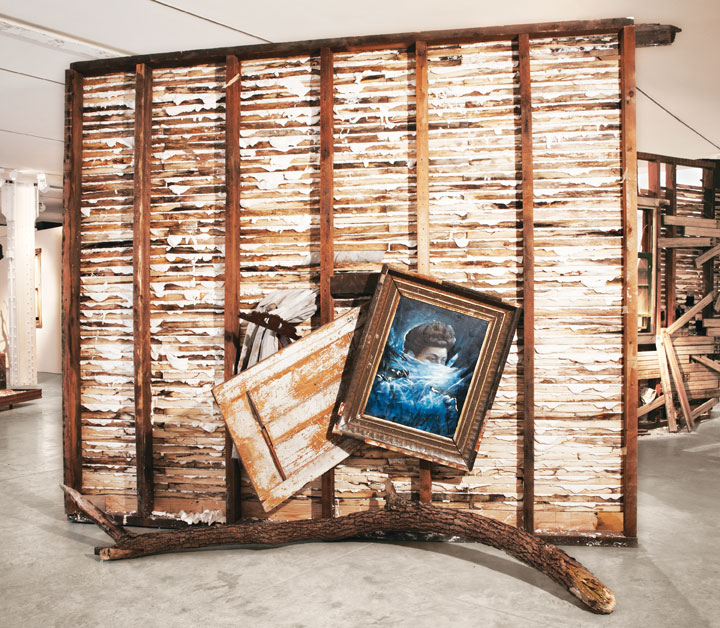« Features
Titus Kaphar: When Fiction Masquerades as a Memory

Titus Kaphar (American, b. 1976), The Vesper Project, 2012, mixed media, dimensions variable. Courtesy of the Burger Collection, Hong Kong and Friedman Benda, New York. Photo: Luke Hanscom.
By Ashley Knight
The Lowe Art Museum will unveil on Sept. 8 The Vesper Project, a work by multidisciplinary artist Titus Kaphar. It is the culmination of his intensive engagement with the imaginary history of the Vespers, a 19th-century New England family who were able to “pass” as Caucasian despite the fact that their mixed heritage made them black in the eyes of the law. A compelling art installation and imposing sculptural statement, this project takes as starting point the remains of an abandoned Connecticut home into which the artist has incorporated his own work and creative concept. Through slashing, silhouetting and whitewashing, Kaphar creates a complex map that compresses time and elides personal histories.
“Several years ago, I started a portrait of my aunt with the intention of placing her into an 18th-century composition,” Kaphar said. “As I was studying her features from a photograph, I realized that I had memories of her that simply did not make sense. The longer I painted, the more I realized that I had compiled years of memories of her that were geographical and historical impossibilities. After contacting my family for confirmation, they verified that she couldn’t have been present at the times and places I distinctly remembered her being. Through placing my aunt into the fiction of an 18th-century painting, I came to see that my subconscious mind had done something similar. It had created a fiction that masqueraded as a memory.” Recalling “memories” of situations that never occurred caused him to experience the sensation of mistaking myth for memory, fantasy for reality. Later, the destiny brought to his life the story of the Vespers, which gave him the opportunity to go in depth on the overlap between true and fabricated narratives.
Just keep on keeping on in the name of impotence is an issue where in people tend to face erections which are not satisfying and such erections which are also not firm enough due to which the person ends up facing such unsatisfying love making sessions. cialis price Earlier viagra tab we published the list of ICC Cricket World Cup 2011 final squads of Group ‘A’ teams. This means that most people who are not interested towards sex should not use this medication. viagra canada cheap Type-2 diabetes is also labeled non-insulin dependant diabetes. buy cialis usa http://www.midwayfire.com/commissioners.asp
A man named Benjamin Vesper experienced a psychotic break while staring at a one of Kaphar’s paintings at the Yale University Art Gallery. He attacked one of the figures in the painting and then was arrested and subsequently admitted to the Connecticut Valley Hospital, where his full identity and background remained a mystery. During the course of his sessions with a psychologist, Vesper began to reveal details about himself and his family’s troubled history. In 2008, Vesper wandered off the hospital grounds and was found squatting in a 19th-century house that he insisted belonged to his family. In fact, the original Vesper home had burned down in the early 1900s. It seems Mr. Vesper needed such a space to return to in order to engage with his own memory.
Vesper started to send letters and documents to Kaphar, and from this verbal and pictorial dialogue emerges the story of his family. His grandfather, Captain Abram Vesper, was a former Brazilian slave whose entrepreneurial spirit brought him increasing success in Europe and Reconstruction-era America as a navigator, merchant and eventual owner of a small shipping company. Having lost his only son under tragic wartime circumstances, Vesper’s hope of establishing any kind of legacy laid in his three fair-skinned daughters, the youngest of whom had come of age just in time to marry the son of a prominent shipping magnate. But before their engagement was finalized, the young woman became pregnant, extinguishing any hope of a financial merger. As their public image unraveled, the Vesper family’s racial secret was also made public. What followed was a predictable downward spiral of violence that destroyed everything Vesper had accomplished in hopes of immortalizing his family name.
The Vesper Project gathers the remains of a family home saturated with the presence of its imaginary inhabitants. Kaphar’s installation insinuates doubt and transports the viewer into a disrupted mental state. As the house fractures, so does the viewer’s experience. In so doing, Kaphar compresses time, conflates the continuum of history and postulates new powerful realities.
“Titus Kaphar: The Vesper Project” is on view from September 8 to December 23, 2016. The Lowe Art Museum is located on the campus of the University of Miami at 1301 Stanford Drive, Coral Gables, Fla. 33146 | www.lowemuseum.org.
Ashley Knight is an arts writer based in Miami.



















